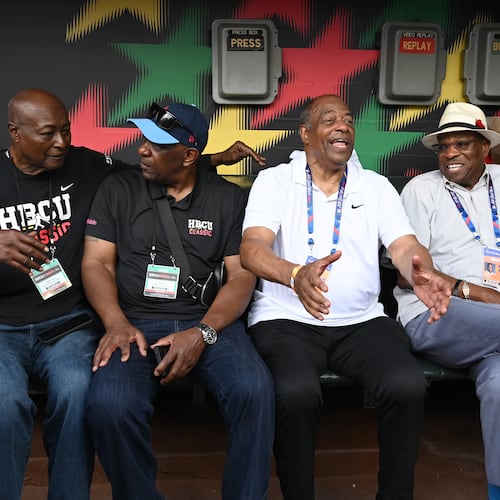NEW YORK – Before the bottom fell out on the Braves bullpen during a seventh inning of Monday’s 6-0 opening loss to the Mets, a close play at the plate let in the first run of the inning and gave the Mets momentum in front of the second-largest regular-season crowd in Citi Field history.
Braves manager Brian Snitker hadn’t seen the replay or talked to catcher Tyler Flowers, so he wasn’t sure why Flowers was several feet behind the plate to receive the strong one-bounce throw from center fielder Ender Inciarte for the would-be second out of the inning.
Snitker just knew the play turned out to be huge when the initial “out” ruling was challenged by the Mets and reversed after replays showed that Wilmer Flores got his foot in front of the mitt as Flowers lunged to make the tag. The run put the Mets ahead 1-0, and the Braves bullpen would face seven more batters and give up five more runs in the inning.
“I don’t know what happened there, if the ball took (Flowers to that spot),” Snitker said. “Like I said, I haven’t had a chance to look at it before I can answer that…. That was a big momentum shift. Probably turns the game around.”
Flowers faced reporters afterward and explained, in detail, what happened on the play and why the veteran catcher set up where he did to field the throw.
“Looking back at it, I would have played it a little more do or die,” said Flowers, meaning he would set up for the throw in front of the plate, not behind it. “I mean, you’ve got to get the ball first. You can stand in the way and do whatever you want to do, if you don’t have the ball he’s safe. Priority 1 is trying to set yourself up in a position to be able to read the hop, eliminate the in-between hop. I like to be behind the plate, giving myself the margin for error that way and create your own hop, all the while anticipating wherever the plate is in relationship to you getting everything going that way.
“If I would have been in a conventional (position) in front of the plate, it would have been a tough play. You’re talking about an in-between short hop; maybe I get it, maybe I don’t. So either, looking back, he would have been out if I had it and if I don’t catch it we’re not talking about (the play). I think in the long haul, the way we’ve been playing it and the way I play it, I think it’s the smarter play. I think it gives me a much better opportunity to secure the ball more often than not and give myself a chance to make a tag play, versus not even coming up with it.”
Flowers said that was the first time he could recall the positioning behind the plate causing him to not get an out.
“I like to set up behind the plate to begin with, so that I’m not going back (to catch a throw),” he said. “Any adjustment you make is going in, as you’re reading the throw coming in, if it’s going to be a long hop to you or a short hop. If it’s going to be a short hop and I’m already back, I can probably come up and catch it in the air. If it’s going to be a longer hop then I can start to move towards the plate. It creates a good gauge, too, because you don’t want to be in the conventional spot and backing up, trying to field a long hop or a short hop as your momentum’s going backward, then trying to get yourself over the plate.
“It’s kind of what I’ve come up with. It’s been succeesful for me in giving myself a chance to make plays. I think that’s the first time that it hasn’t resulted in an out.”
About the Author
Keep Reading
The Latest
Featured



